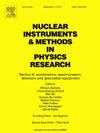使用基于fpga的系统开发开源核事件识别管道:数据采集,噪声滤波,梯形成形以及电离和闪烁检测技术的基准测试的综合方法
IF 1.5
3区 物理与天体物理
Q3 INSTRUMENTS & INSTRUMENTATION
Nuclear Instruments & Methods in Physics Research Section A-accelerators Spectrometers Detectors and Associated Equipment
Pub Date : 2025-04-24
DOI:10.1016/j.nima.2025.170546
引用次数: 0
摘要
本研究解决了在核辐射分析和粒子检测中对高速检测和处理系统的需求,特别是对于像DUNE这样的关键实验。基于盖革和闪烁探测器对钍232 (232Th)、镅241 (241Am)和钴60 (60Co)样品的采集信号,开发了数字信号处理管道。该管道结合了FIR滤波器和梯形整形器的设计和实现,以提高信噪比,并通过脉冲高度鉴别器实现能量估计。在AMD Xilinx ZYNQ 7000 SoC上的流水线验证实现了89%的信号建模精度,并减少了事件中的堆积效应。多通道频谱分析仪在模拟和实际事件采集中成功地区分了不同能量通道的事件,生成了放射性同位素的能谱。为了强调开源工具开发的重要性,这项工作可以在公共存储库中访问。作为未来的工作,提出了一个可重构和可访问的处理系统平台的设计,同时还提出了用其他同位素、探测器和更高速度和分辨率的adc验证管道。本文章由计算机程序翻译,如有差异,请以英文原文为准。
Development of an open-source nuclear event discrimination pipeline using FPGA-based systems: Comprehensive approach with data acquisition, noise filtering, trapezoidal shaping, and benchmarking with ionization and Scintillation detection technology
This study addresses the need for high-speed detection and processing systems in nuclear radiation analysis and particle detection, particularly for critical experiments like DUNE. A digital signal processing pipeline was developed, based on acquiring signals from Geiger and Scintillation detectors for Thorium 232 (), Americium 241 () and Cobalt 60 () samples. This pipeline incorporates the design and implementation of a FIR filter and a trapezoidal shaper to enhance the signal-to-noise ratio and enable energy estimation through a pulse height discriminator. Validation of the pipeline on an AMD Xilinx ZYNQ 7000 SoC achieved an 89 % signal modeling accuracy and reduced the pile-up effect in events. The Multichannel Spectrum Analyzer successfully discriminated events across different energy channels in both simulation and real event acquisition, yielding energy spectra for radioactive isotopes. Emphasizing the importance of open-source tool development, this work is accessible in a public repository. As future work, a design for a reconfigurable and accessible platform from the processing system is proposed, alongside validating the pipeline with other isotopes, detectors, and higher-speed and resolution ADCs is also proposed.
求助全文
通过发布文献求助,成功后即可免费获取论文全文。
去求助
来源期刊
CiteScore
3.20
自引率
21.40%
发文量
787
审稿时长
1 months
期刊介绍:
Section A of Nuclear Instruments and Methods in Physics Research publishes papers on design, manufacturing and performance of scientific instruments with an emphasis on large scale facilities. This includes the development of particle accelerators, ion sources, beam transport systems and target arrangements as well as the use of secondary phenomena such as synchrotron radiation and free electron lasers. It also includes all types of instrumentation for the detection and spectrometry of radiations from high energy processes and nuclear decays, as well as instrumentation for experiments at nuclear reactors. Specialized electronics for nuclear and other types of spectrometry as well as computerization of measurements and control systems in this area also find their place in the A section.
Theoretical as well as experimental papers are accepted.

 求助内容:
求助内容: 应助结果提醒方式:
应助结果提醒方式:


